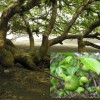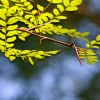 This sturdy, pocket-sized field guide–the only one of its kind for north and central Florida–is designed for landscape professionals, arborists, naturalists, gardeners, and anyone seeking to know the trees around them. Full color photographs of leaves, bark, flowers and full trees, together with clear descriptions and other information make identifying trees easier than ever. The book also features a handy diagnostic key, an introduction to plant parts, a glossary and a ruler to guide you, whether you’re a trained botanist or a total beginner. This field guide to 140 common tree species is written by Andrew Koeser, Gitta Hasing, Melissa Friedman, and Robert Irving and published by UF/IFAS. Available only at the UF/IFAS Extension Bookstore.
This sturdy, pocket-sized field guide–the only one of its kind for north and central Florida–is designed for landscape professionals, arborists, naturalists, gardeners, and anyone seeking to know the trees around them. Full color photographs of leaves, bark, flowers and full trees, together with clear descriptions and other information make identifying trees easier than ever. The book also features a handy diagnostic key, an introduction to plant parts, a glossary and a ruler to guide you, whether you’re a trained botanist or a total beginner. This field guide to 140 common tree species is written by Andrew Koeser, Gitta Hasing, Melissa Friedman, and Robert Irving and published by UF/IFAS. Available only at the UF/IFAS Extension Bookstore.
Tag: Native Trees
Hippomane mancinella, Manchineel (FOR302/FR370)
 This poisonous tree is native to southern Florida, the Keys, many of the Caribbean islands, Mexico, and Central America. Though it is poisonous to humans and many animals, iguanas are eat the fruit and sometimes live among the tree’s limbs. It’s found along the seacoasts and in brackish swamps where it grows among mangroves. Each leaf has a small gland where the leaf joins the stem. The bark is reddish-to-grayish brown and cracked looking. Flowers inconspicuous, but the spikes or leafless stems that the flowers emerge from are visible. The fruit is bright-green and looks like a small apple. This 2-page fact sheet was written by Michael G. Andreu and Melissa H. Friedman, and published by the UF Department of School of Forest Resources and Conservation, July 2012.
This poisonous tree is native to southern Florida, the Keys, many of the Caribbean islands, Mexico, and Central America. Though it is poisonous to humans and many animals, iguanas are eat the fruit and sometimes live among the tree’s limbs. It’s found along the seacoasts and in brackish swamps where it grows among mangroves. Each leaf has a small gland where the leaf joins the stem. The bark is reddish-to-grayish brown and cracked looking. Flowers inconspicuous, but the spikes or leafless stems that the flowers emerge from are visible. The fruit is bright-green and looks like a small apple. This 2-page fact sheet was written by Michael G. Andreu and Melissa H. Friedman, and published by the UF Department of School of Forest Resources and Conservation, July 2012.
http://edis.ifas.ufl.edu/fr370
Gleditsia aquatica, Water Locust (FOR301/FR369)
 Water locust’s wide, spreading root system and affinity for hydric conditions makes it a useful specimen for erosion control on wet banks of freshwater systems. While not widely available, planting this tree in residential yards or other public locations may be less than ideal, since the long and sharply pointed thorns on the main trunk and branches can be hazardous. This deciduous tree is native to Florida. This 2-page fact sheet was written by Michael G. Andreu, Melissa H. Friedman, and Robert J. Northrop, and published by the UF Department of School of Forest Resources and Conservation, July 2012.
Water locust’s wide, spreading root system and affinity for hydric conditions makes it a useful specimen for erosion control on wet banks of freshwater systems. While not widely available, planting this tree in residential yards or other public locations may be less than ideal, since the long and sharply pointed thorns on the main trunk and branches can be hazardous. This deciduous tree is native to Florida. This 2-page fact sheet was written by Michael G. Andreu, Melissa H. Friedman, and Robert J. Northrop, and published by the UF Department of School of Forest Resources and Conservation, July 2012.
http://edis.ifas.ufl.edu/fr369
FOR200/FR262 English Creek Native Tree and Plant Tour
FOR200, a 3-page fact sheet by Michael G. Andreu, Melissa H. Friedman, and Mary E. Thornhill, Describes the English Creek Preserve Native Tree and Plant Tour, with instructions for downloading and printing out a guidebook designed for use along the raised boardwalk trail, although it can also be used to identify trees and plants outside the preserve. Published by the UF School of Forest Resources and Conservation, October 2008.
http://edis.ifas.ufl.edu/FR262